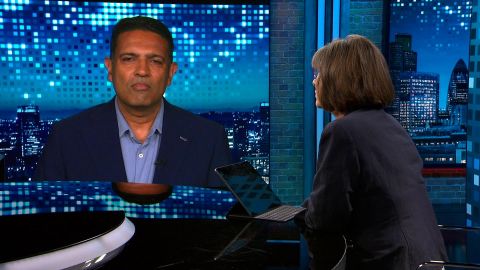Read Transcript EXPAND
CHRISTIANE AMANPOUR, CHIEF INTERNATIONAL ANCHOR: So, are you concerned and should we all be concerned by Google’s announcement that it’s testing an A.I. program that will write news stories and that people or organizations like A.P., Bloomberg, are already using A.I., as we know, creators said, “Free journalists up to do better work.” Do you buy that? And what are the dangers of, you know, a whole new program that would just write news stories?
SREENIVASAN: I think that that’s an inevitable use case. Again, I wish I could be an optimist about this, but every time I have heard that refrain that this will free people up to do much more important tasks, I mean, if that were the case, we would have far more investigative journalism, we would have larger, more robust news rooms because all of those kinds of boring, silly box scores would be written by bots. But the inverse is actually true. Over the past 15 years, at least in the United States, one in four journalists have been laid off or is now out of the profession completely. And lots of forces are converging on that, but if you are caring about the bottom line first, and a lot of the companies that are in the journalism business today are not nonprofits, are not doing this for public service good, they are wanting to return benefits to shareholders if they see these tools as an opportunity to cut costs, which is what they will do, then I don’t think it automatically says, well, guess what, we will take that sports writer that had to stay late and just do the box scores for who won and who lost the game, and that women or that man is now going to be freed up to do fantastic, important, civically minded journalism. That is just hasn’t happened in the past and I don’t see why, if you’re a profit driven newsroom, that would happen today.
AMANPOUR: Well, to play devil’s advocate, let me quote the opposite view, which is from “The New York Times” president and CEO. She says, you cannot put bots on the frontlines in Bakhmut, in Ukraine, to tell you what is happening there and to help you make sense of it. So, she is saying, actually, we do and we want and we will keep investigating precisely the people you are seeing who are going to get laid off.
SREENIVASAN: Yes. Well, “The New York Times” is a fantastic exception to the rule, right? “The New York Times,” perhaps two or three other huge journalism organizations can make those investments because they are making their money from digital subscriptions, they have multiple revenue streams. But let’s just look at, for example, local news, which, you know, I want to say an enormous percentage of Americans live and what are known as local news deserts, where they don’t actually have local journalists that are working in their own backyard. Now, when those smaller newsrooms are under the gun to try to make profits and try to stay profitable, I don’t think that these particular kinds of tools are going to allow them to say, let’s go ahead and hire another human being to go do important work. I think there’s a lot more cost cutting that’s going to come to local journalism centers because they are going to say, well, we can just use a bot for that. What do most people come to our website for? Well, they come for traffic and they come for weather. And guess what? Weather is completely automated now and we could probably have an artificial robot or an artificial intelligence kind of a face, like you or me, just give the traffic report, if that’s what needs to be — anything else.
AMANPOUR: Well, you know, you just lead me right into the next question or sort of example, because some news organizations, TV stations, you and I work for TV stations, especially in Asia, are starting to use A.I. anchors. Here’s a clip from one in India.
(BEGIN VIDEO CLIP)
UNIDENTIFIED FEMALE: Warm greetings to everyone. Namaste. I am OTV and Odisha’s first A.I. news anchor, Lisa. Please tune in for our upcoming segments where I will be hosting latest news updates coming in from Odisha, India and around the world.
(END VIDEO CLIP)
AMANPOUR: Yikes.
SREENIVASAN: Yes. And, you know — and look, this is just the first generation of, I want to say this woman, but it’s not, right? And her pronunciation is going to improve, she’s going to be able to deliver news in multiple languages with ease. And you know what, there’s — she’s never going to complain about long days. These are similar kind of challenges and concerns. And, you know, I have not seen any A.I. news people unionize yet to try to lobby or fight organizations for better pay or easier working conditions. I mean, you know, right now, you know, again, same thing, you could say, it would be wonderful if one of these kinds of bots can just give the headlines of the day, the thing that kind of takes some of our time up so we could be free to go do field reporting, et cetera. But that is not necessarily what the cost benefit analysis is going to say. Well, maybe, we can cut back on the field reporting and we can have this person do more and more of the headlines, as the audience gets more used to it, just like they’ve gotten used to people video conferencing over zoom, maybe people are not going to mind. Maybe people will develop parasocial relationships with these bots, who knows? Again, this is like very early days. And, you know, I’m old enough to remember a TV show called “Max Headroom.” And we are pretty close to getting to that point.
About This Episode EXPAND
Christiane hosts a panel of leaders in the field of artificial technology. In a world where it’s increasingly hard to discern fact from fiction, Hari Sreenivasan and Christiane Amanpour discuss the ethical dilemmas of A.I., and why it’s more important than ever to keep real journalists in the game.
LEARN MORE

